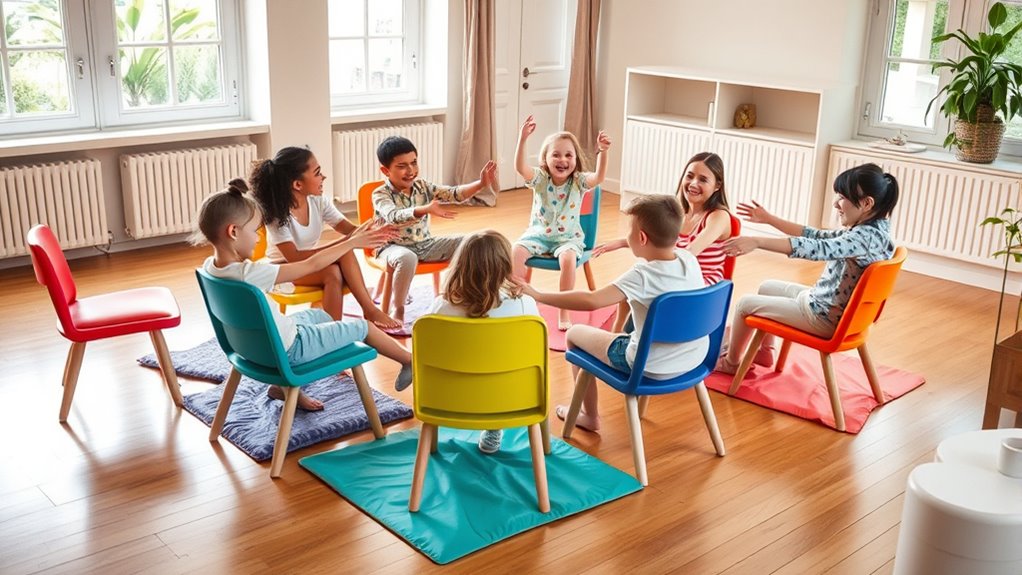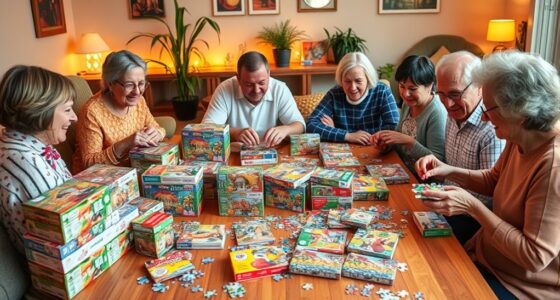If you want to reinvent musical chairs into a cooperative game that skips tears, focus on inclusive variants that keep everyone in play. Instead of elimination, try games where players work together to reach seats, form human chains, or share chairs through teamwork. These versions promote patience, social skills, and shared fun while reducing competition. Exploring these ideas can help you create a more positive experience—if you keep exploring, you’ll find ways to make your game even more engaging.
Key Takeaways
- Modern cooperative musical chairs focus on inclusivity, allowing all players to stay in play and collaborate instead of competing.
- Variants involve group challenges like forming human chains or shared seating to promote teamwork.
- These versions eliminate elimination, reducing frustration and encouraging positive social interactions.
- Games are designed to foster patience, cooperation, and social skills across all ages and abilities.
- Educators and communities use inclusive strategies, like mailing lists, to share innovative, tear-free musical chairs ideas.

Traditional musical chairs is getting a modern makeover, transforming a classic game into an innovative, interactive experience. This timeless activity has a rich musical chairs history, dating back over a century, originally designed as a lively way for kids to burn energy and have fun. Over time, however, its competitive nature sometimes led to tears and frustration, especially among younger players. Today, game designers and educators are reimagining musical chairs by exploring innovative game variants that emphasize cooperation rather than competition. These new versions aim to keep everyone engaged and smiling, avoiding the usual chaos and disappointment.
The traditional game involved players rushing to find a seat when the music stopped, with one person left standing and eliminated each round. While simple and entertaining, it often became cutthroat, especially in larger groups where the pressure to secure a chair could lead to disagreements. Recognizing this, creators of innovative game variants have shifted the focus from elimination to inclusivity. These versions often feature multiple chairs, shared seating arrangements, or collaborative goals that encourage players to work together rather than compete against each other. For example, some variants involve all players moving together in a synchronized manner, where the goal is to find a seat as a team rather than individually racing for a spot. This approach fosters cooperation, patience, and shared enjoyment.
Incorporating music and movement remains central, but the rules now promote positive interactions. Instead of removing players, some adaptations have everyone remain in play, with the game emphasizing movement patterns or creating challenges that require players to help each other. For instance, players might need to form human chains or work in pairs to reach the seats. These innovative game variants are particularly popular in schools and community centers because they help build social skills and reduce the competitive tension that can turn kids off from traditional musical chairs. Plus, they make the game more accessible for players of all abilities, ensuring everyone feels included. Additionally, integrating mailing list strategies can help educators share these inclusive game ideas more effectively with other teachers and community organizers.
Frequently Asked Questions
How Can Musical Chairs Be Adapted for Different Age Groups?
You can adapt musical chairs for different age groups by making age-appropriate modifications that guarantee inclusive gameplay. For younger children, reduce the number of chairs, slow down the music, or add fun themes. For older players, incorporate teamwork or relay elements to keep it engaging. These changes help everyone participate comfortably, fostering cooperation and fun across all ages. Adjusting rules and setup makes musical chairs suitable for any age group.
What Materials Are Best for Creating Cooperative Musical Chairs Games?
Research shows that using soft, lightweight materials enhances safety in DIY crafts. For cooperative musical chairs, opt for foam mats, fabric-covered cushions, or sturdy but gentle plastic pieces. These materials minimize injury risk and encourage inclusivity. Always consider safety considerations, ensuring the materials are non-slip and free of sharp edges. By choosing appropriate, safe materials, you create a fun, cooperative game that’s engaging and secure for all ages.
Are There Any Digital or Virtual Versions of Cooperative Musical Chairs?
You can find virtual adaptations of cooperative musical chairs on various digital platforms. These games often use online multiplayer features, allowing players to collaborate and compete in real-time from different locations. Platforms like Zoom, dedicated gaming sites, or custom apps enable you to create engaging, cooperative experiences. They skip the tears by emphasizing teamwork and fun, making them perfect for remote gatherings, classrooms, or online parties.
How Do You Modify Rules to Promote Teamwork Over Competition?
They say teamwork makes the dream work, and that’s true for game modifications. To promote teamwork over competition, you can implement team building strategies like collaborative goal setting or shared rewards. Adjust rule modifications so players work together to find solutions or pass the music, rather than competing for spots. This encourages cooperation, enhances communication, and shifts focus from winning to collective fun. Remember, the goal is unity, not just individual victory.
What Are the Benefits of Playing Cooperative Musical Chairs for Children?
You’ll see that playing cooperative musical chairs helps children develop essential skills like teamwork and empathy. It promotes emotional development by encouraging kids to support each other, rather than compete. As a team-building activity, it fosters communication and patience, making the game more inclusive and fun. Kids learn to work together, building positive relationships while enjoying the game, which benefits their social and emotional growth long-term.
Conclusion
As you step into these new cooperative versions of musical chairs, you realize the game isn’t about competition but connection. The laughter replaces tears, and teamwork replaces rivalry. It’s a invigorating shift—from the chaos of the traditional game to moments of shared joy. While the old version left some feeling left out, these reinvented games remind you that winning isn’t everything; sometimes, the real prize is simply playing together.











